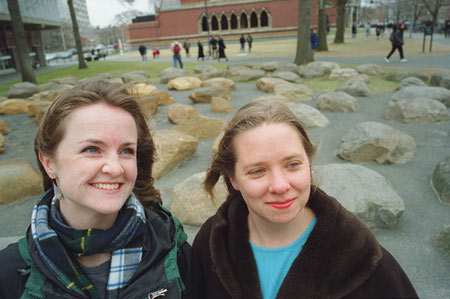Designing women
Students stun, winning grand prize in national competition

When Gweneth Newman and Katherine Alberg Anderson decided to enter a design competition as a final project in their course on watershed management, they had no idea that they would end up $5,000 richer.
Newman and Anderson, both students in the Master in Landscape Architecture program at the Graduate School of Design (GSD), won the grand prize in a competition sponsored by the Massachusetts Institute of Technology (M.I.T.) and the Environmental Protection Agency (EPA). The competition was intended to elicit creative ideas for utilizing rainwater on residential property rather than let it run off into storm drains where it can cause problems.
In the blind competition, the judges chose the students’ design over those of professionals, including the authors of textbooks that Newman and Anderson used in their course.
“Everyone was surprised that the students beat out the professionals,” said Robert France, associate professor of landscape ecology in the GSD, who teaches the course in which the two students were enrolled: “Watershed and Waterside Development, Planning, and Design.”
In addition to sharing the grand prize, Newman and Anderson will receive an additional $10,000 to implement their design on a property provided by M.I.T.
The students are clearly excited about their victory and the opportunity it will give them to showcase their ideas.
“It’s kind of exciting that you have this resource on your property and that you can do something with it,” Anderson said.
“If we can stimulate developers to influence the choices that people make about their properties, it might really add up to something,” said Newman.
The problem that Newman and Anderson grappled with is one that has scarcely captured the public’s attention, and yet, according to environmental biologists like France, it is an issue with serious repercussions for water conservation and public health.
The problem stems from the fact that most properties, from high-rise office buildings to suburban single-family houses, are not designed to absorb and utilize rainwater. As a result, most of the rainwater collects as runoff and enters the storm sewers. On the way, it picks up impurities, including infectious bacteria from animal waste as well as harmful pesticides and fertilizers. This polluted runoff then enters local streams and rivers.
“It’s scary stuff,” said France, “a cocktail of organic and inorganic pollutants.”
The solution lies in designing buildings and surrounding landscapes that allow for collecting and “harvesting” rainwater, rather than sending it downstream.
“What’s needed is a paradigm shift,” said France. “We need to have an infiltration mentality rather than a conveyance mentality.”
An infiltration mentality would mean controlling runoff at the source rather than try to fix the problems that occur when polluted water enters vulnerable streams. Such a program would also help to control flooding by slowing down the movement of rainwater through the watershed. Many European countries are ahead of the United States in dealing with these problems by mandating that new construction incorporate design features that allows more rainwater to be harvested.
The design that Newman and Anderson submitted actualizes France’s paradigm shift in a number of ways. These include using porous pavers to allow rain to seep through garden paths into the earth below; a rain barrel for collecting runoff from the roof to be used later to water plants; rainwater gardens which collect and filter stormwater; and a rain chain pergola, consisting of hanging copper funnels that guide rainwater into the gardens while providing visual and aural interest.
One of Newman and Anderson’s aims was to “celebrate” rainwater in addition to satisfying the competition’s utilitarian requirements. France believes that this feature of their work may have influenced the judges to select their design as the grand prize winner.
“Their design was just beautiful,” he said. “It’s a wonderful marriage of science and design. I think the EPA judges were tickled pink by the concept of celebrating rainwater. Engineers are used to treating stormwater functionally. They don’t learn about these small-scale, aesthetically pleasing ways of solving problems.”
Newman and Anderson agree that it was probably the aesthetic dimension of their work that caught the judges’ eyes, but they also believe its practical aspects had a lot to do with their win as well.
“One of the things we tried to do was appeal to all the senses,” said Newman.
“It’s also both doable and durable,” said Anderson. “Homeowners could actually build it themselves. And it’s not particularly precious. You could have families using it with kids running around, and the impact on the landscaping would be minimal.”




